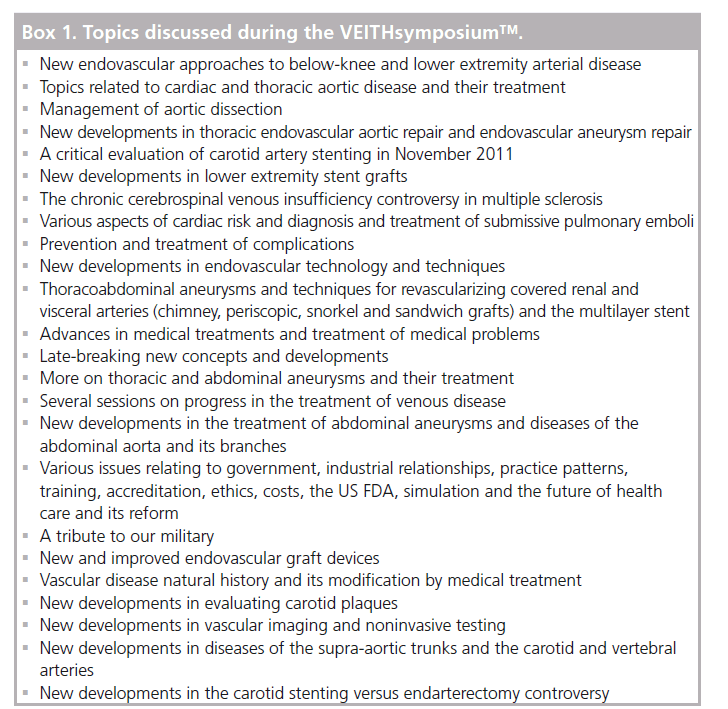Conference Scene - Interventional Cardiology (2012) Volume 4, Issue 2
38th Annual VEITHsymposium
- Corresponding Author:
- Frank J Veith
The Cleveland Clinic, New York University Medical Center, NY, USA
E-mail: FJVMD@msn.com
Abstract
The 38th Annual VEITHsymposium™ was held on 16–20 November 2011 at the Hilton New York (NY, USA) and was sponsored and accredited by the Cleveland Clinic (OH, USA). At this meeting, 533 faculty members from multiple specialties presented their views on various aspects of vascular disease. More than 4200 delegates with a vascular interest from all five continents and most countries in the world attended the meeting and there were over 650 individual presentations. In addition to being presented orally, talks (with their synchronized slides) and their related panels were recorded in their entirety and will be available on a web-based version of the meeting (see [1]) for those who missed talks or wish to refresh their memory of them.
On the first day of the meeting, there were six simultaneous components dealing with endovenous management of varicose veins (led by Jose Almeida, Miami Vein Center, FL, USA, and Lowell Kabnick, New York University, School of Medicine, NY, USA), hemodialysis access (led by Thomas Vesely, MO, USA, and Larry Scher, North Shore University Hospital, NY, USA), new horizons in cardiovascular surgery (led by Roy Greenberg and Bruce Lytle, Cleveland Clinc), wounds (led by Dieter Mayer, University Hospital Zurich, Switerland), and a multidisciplinary approach to stroke management (led by Allan Brook, Montefiore Medical Center, NY, USA). Although there was a great deal of interest and audience participation in the stroke management sessions, the endovenous management of varicose veins and the hemodialysis access components had the largest attendance – sometimes with standing room only audiences. There was also a linked interventional radiology meeting (AIMsymposium™) chaired by Jacob Cynamon (Montefiore Medical Center, NY, USA). In all components new findings and techniques attracted the greatest interest and generated the most excitement. Attendees could circulate through these various component meetings according to their interests. If they missed talks, most of them were captured on the web-based version of the meeting for later review.
Beginning on the second day of the meeting, important areas in vascular disease were discussed in depth at multiple sessions by multiple speakers who presented their views on specific topics in 5–6 min fast-paced talks. These talks were followed by panel discussions in which audience members could discuss the presentations or ask questions. Controversial issues were raised during contentious debates or by having individuals with sharply differing opinions on a topic present their views. Although there were some simultaneous sessions, these were limited to two at a time and usually dealt with widely divergent topics.
Over the last 4 days of the meeting various broad areas were discussed (Box 1). The entire program can be reviewed by accessing the VIETHsymposium website [2].
There were many highlights of the meeting, among the most important were the 26 lively debates on highly controversial topics. Those on carotid stenting versus endarterectomy, the value of chimney/periscope grafts, the role of chronic cerebrospinal venous insufficiency in multiple sclerosis and the value of the multilayer stent in treating complex aneurysms were regarded as the most interesting and stimulating – probably because they contained the greatest amount of new and controversial information. Other highlights included the multiple new developments in the treatment of infrainguinal vascular disease using new interventional techniques and the rapidly evolving treatment of thoracic aortic disease and aortic dissection by endovascular means. Controversial aspects of these new treatments and techniques attracted the greatest interest, probably because they offered the greatest opportunity for interventional specialists to explore new horizons in treatment. There was particular interest in the report by Christoph Nienaber (University of Rostock, Germany) that, after 3 years of follow-up, the INSTEAD trial demonstrates improved outcomes when patients with uncomplicated type B aortic dissections were treated with stent grafts. Other areas of great interest included the transcatheter renal artery radiofrequency treatment of resistant hypertension, new methods for evaluating the risk of asymptomatic carotid plaques and new, better endovascular techniques for dealing with major venous obstruction and pulmonary emboli, including ultrasound-accelerated thrombolysis and a novel suction device that removes large clot burdens.
Of course, many questions were left unanswered awaiting additional data. Thus, although the audience appreciated the cutting edge update in many areas and the airing of controversies, delegates will hopefully return to get more information and further updates in 2012 and beyond.
To learn more about VEITHsymposium 2012 or how to access the VEITHsymposium 2011 on-demand library, visit [2].
Financial & competing interests disclosure
FJ Veith is chairman of VEITHsymposium™. The author has no other relevant affiliations or financial involvement with any organization or entity with a financial interest in or financial conflict with the subject matter or materials discussed in the manuscript apart from those disclosed.
No writing assistance was utilized in the production of this manuscript.


